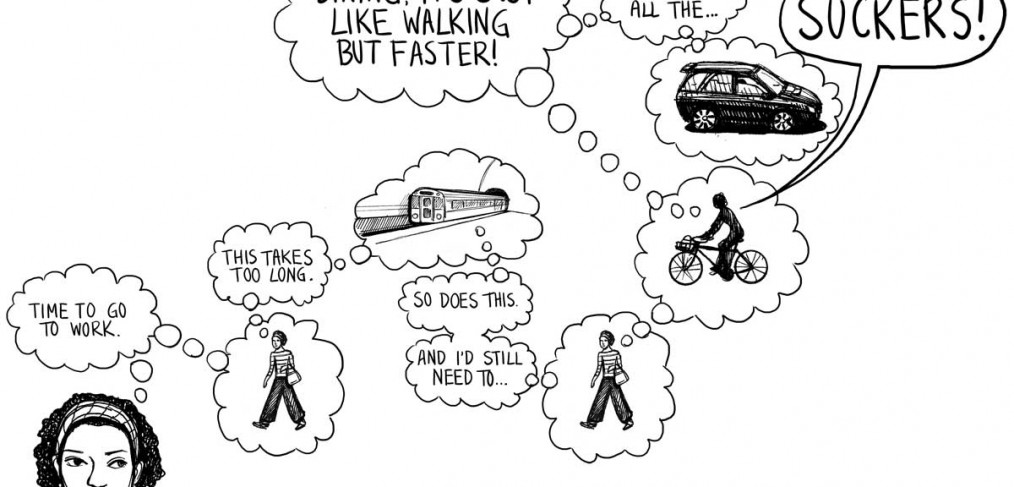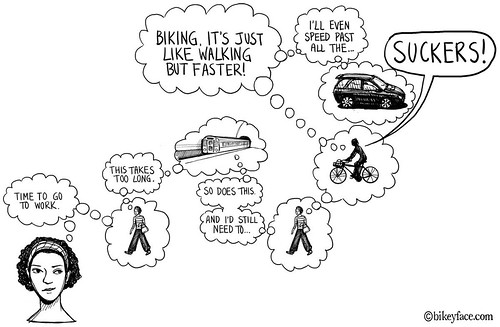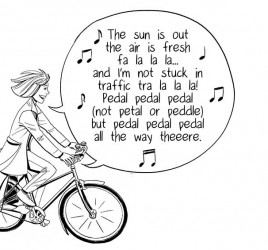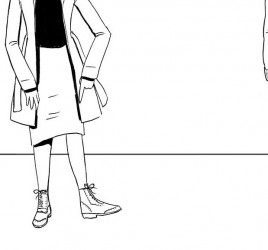
Jaybikers
The other day I was waiting at a red light while a flood cyclists passed by me in every direction. It was a particularly long red, and car traffic was lower than normal. And I’m glad there has been such and increase in biking. However I witnessed several close calls because no one was operating by the same set of rules:
It seemed their main concern was to get from A to B in the shortest, quickest way possible. But it got me thinking about the mindset. There is vehicular cycling, and then there is a more pedestrian approach…
However if you’re just out to get places as fast as possible and not willing to rest on a red, you may just be on a collision course. Stop at a red light sometime and watch what almost happens.






Love your drawings and humor. Missing though are the freaked out pedestrians that get cut-off by jaybikers. Not the people that are walking against the light, but the ones in the crosswalks with the light and enough determination to get across.
oh – fyi – if you’re at a light that only changes with the magnetic loop thingy for cars – and/or you have to leave the road to push the pedestrian signal button – the city of Boston says you can go when all is clear – even if there is a red light. it’s the timed signals you have to wait for.
It’s still usually possible to trigger these lights. The Oregon Bicyclist Handbook (available online, Google should find it fast) has some tips on page 12.
Where I live here in Ontario, we have Dutch-style “Strict Liability” laws that deem motor vehicle drivers to be automatically liable in any crash. The car driver has the burden of proof to establish that he wasn’t liable. See:
http://www.e-laws.gov.on.ca/html/statutes/english/elaws_statutes_90h08_e.htm#BK289
An excerpt:
“When loss or damage is sustained by any person by reason of a motor vehicle on a highway, the onus of proof that the loss or damage did not arise through the negligence or improper conduct of the owner, driver, lessee or operator of the motor vehicle is upon the owner, driver, lessee or operator of the motor vehicle.”
This is one of the reasons why Ontario’s roads are the safest in North Anerica. See:
http://www.mto.gov.on.ca/english/safety/orsar/orsar08/overview.shtml
The cartoon would look far different if the intersection were properly and safely designed in the first place. Here is what safe intersections look like:
And here are several “live” examples of proper intersections in use.
wow – this is fantastic! why can’t they implement this in Boston? This makes so much more sense.
Some cyclists may want to be pushing pedestrian style crossing buttons to call a halt to traffic whenever they want to cross a street. Personally, I prefer the current method, where if the light is green, I can go ahead with all the other road users.
And I have serious doubts that the Dutch system, transferred to the US, would prevent the intersection conflicts that cause most cycling accidents. The Dutch both drive and cycle differently than we do, and they have laws and cultural influences that make people want to operate on the road very differently.
Until we have a completely separate system that completely prevents any car-bicycle interactions, I’ll stick with the road. It has over a century of tried and tested engineering principles behind it. Segregated cycling infrastructure is still in its infancy, and its safety record is not good compared to the old fashioned alternative. See http://ianbrettcooper.blogspot.com/2012/08/bicycle-infrastructure-studies.html
well – without even imperfect bike facilities there is absolutely no way we’ll see a critical mass of people getting around by bike to even begin this sort of conversation of separate infrastructure – only an extremely small group of people are willing to ride in the road – even if it is “safer.” (do you have any idea what it was like riding in Boston 10+ years ago?). and it’s 80 years of auto-centric engineering – paid for by the auto-industry. bicycles are not cars.
“without even imperfect bike facilities there is absolutely no way we’ll see a critical mass of people getting around by bike…”
People say that a lot. It’s based on two fundamental misconceptions:
1. That people need specialized infrastructure in order for cycling to become popular. This is not true. The Dutch and Danish were cycling at much higher rates than they are now before the first specialized cycling facilities were installed in the Netherlands or Denmark. If anything, the rise of bicycle facilities in those countries coincides with a drop in rideshare.
2. That people are willing to cycle on a type of infrastructure that is more dangerous than another type. Once people start to appreciate that bike facilities have known and clear hazards associated with them, it will cause a backlash. A deception can only fool all of the people some of the time. I fear we are going down a path which, far from popularizing cycling as a popular mode of transport, will end up destroying its potential.
A big part of the problem with cycling advocacy today is that bike facility advocates spend a lot of their time saying how dangerous the road is. They do this in an effort to sell bike facilities, but all it does is frighten people from cycling altogether.
There is a better way. It involves calling out imperfect bike facilities and aggressively seeking the least hazardous solutions based on rational (rather than romantic) principles.
Bikes are not cars, but they are vehicles, and all vehicles interact best when the transportation system they are required to interact on is simple and easy to navigate. Squeezing segregated bike facilities into a system that is extensive and over a hundred years old is a mistake that will cost lives. Fewer people will die if we seek ways to make the current road system work for every user. The answer is integration, not segregation, and it has to happen on a road system that is reduced in speed and designed for all, not just for the heaviest and fastest.
Speed reduction, not segregation, is the key to a cycling utopia. The fact is, 90% of US roads are already perfectly cyclable without infrastructure. These are the low speed residential roads that form the basis of the transport network. All we need to do is find ways of making the other 10% cyclable. Then there will be no need for specialized (and expensive) cycling paths.
I see a future in which the maximum speed on any surface road is 30mph – and then only the major inter-city arteries where there is no freeway. Freeways can still have their 65mph limits. All other roads will have 20mph limits, so that ALL users can achieve the speed limit. Only in this way will we get a transportation system that is equitable. I use the word ‘segregation’ to describe bike facilities for good reason. Specialized bike facilities are like 1950s racial segregation – they are a system built to support inequality. Even if all roads get bike facilities, that will not make cyclists equal – in fact it can only ever cement their inequality.
Ian: first of all, if the cycling rates were higher in Denmark and the Netherlands before the prevalence of cycle facilities, it’s because it was also before the prevalence of automobiles – there was a notable drop in cycling rates in both countries between the 1950’s and the 1970’s, after which they built separated infrastructure (as well as revised laws, education, and redesigned much of the entire road infrastructure), and cycling rates have gone up again considerably since then.
Secondly, do you see many 8-yr-old children cycling at 20mph? How about 70-yr-old adults? People with several days groceries on their bike? People who have 40 miles to from beginning to end? No? Right, because they generally don’t or even can’t. I’m not even sure I can hit 30mph on my bike unless I’m going down a significant hill, and I’m a mid-thirties male. I do think speed limits should be categorically reduced on surface city streets (differentiating from automobile-only ‘freeways’), but that’s not a complete solution either, unless we can effectively keep most motor vehicles around 10mph, which is extremely unlikely.
That’s the big flaw with the strict vehicular cyclist viewpoint. I think the vehicular cycling concepts give us good tools to use on the roads as they exist in N. America, UK, etc. But they, as the only system, *do not* allow for everyone in society to cycle, plain and simple.
I don’t think every road needs separated cycle facilities, in fact, maybe most of them don’t (depending on the city), and if you actually go to Denmark or the Netherlands, you’ll see that not all roads have them. They are installed or not based on context.
But, I think well-designed separated infrastructure can make all the difference *in the right places*. The problem is, for the most part, North America and the UK seem to be pretty much devoid of *well-designed* cycling infrastructure, which is where a lot of the backlash comes from. Of course, we should get upset when our governments build us death-traps. But just because they built us a death-trap doesn’t mean that *every cycling facility* is a death-trap.
Of course, infrastructure is not all – the Dutch system is a package. Infrastructure, education, law. You have to hit all of it.
dave, i think ian’s 30 mph speed limit is so that the speed difference between cyclists and cars is such that car driver have enough time to safely and comfortably pass cyclists. 30mph limit implies passing speed of 10 to 20 mph, i could definitely live with that. not sure drivers would, though.
Ian – Do you ride in Boston – or in a city? – yes most places it makes sense to simply lower the speed limit b/c traffic is moving at a constant rate – but on congested urban roads would you rather filter (anyone here remember attempting to do this on mass ave before they installed lanes?), sit in traffic, or glide along on the space provided by lane? I ride in places where traffic often moves at 0 to 1mph – and without the lane – if I wanted to keep moving I’d potentially be doored from both sides, pinned in by trucks, forced to out in the middle stripe (or worse salmoning in oncoming traffic), or have the cops chasing after me for riding on the sidewalk. it’s not perfect, but it’s better than it was.
also – here’s survey data from Portland OR about why people do and do not ride bikes:
http://www.portlandoregon.gov/transportation/article/158497
“Ian – Do you ride in Boston – or in a city?…”
I ride in Silver Spring, MD. I used to commute in Somerville, MA, Boston and Cambridge. Before that, I cycled in Birmingham, UK. Apart from my cycling tour of Europe in the 1980s, I have only ever cycled in large cities.
I never filter – it’s suicide. I think cyclists who do it need a damned good thrashing – or better still, an education about why it’s so dangerous.
But anyway, I’m unclear about why you think reductions in speed limits are unworkable in cities. It’s not traffic jams that are a problem. It’s when the traffic starts to move – and to move fast.
Regarding your survey of why people do and don’t ride bikes, the thing is, we need to change cyclists who lack confidence into cyclists who are confident. We can achieve that by reducing speed limits and educating people about how cycling in traffic is a very safe activity – safer than driving a car. We will never make people confident on bikes by installing segregated facilities that confirm their fears by making them more vulnerable at intersections, nor will we achieve it by arguing that the road (which has always been the safest place to cycle) is scary and dangerous.
My cycling formative years were in the late 70’s where there was no blogs, books, nor Copenhagen from which to learn bike safety and etiquette. You just learn heuristically: I remember the first time where I salmon up a road with cars coming at me at 45 mph! Or the first time I didn’t lose my nerve when a city bus squeezed by at 2 feet. You just develop a riding intelligence over the years to keep you (relatively) safe. While it would be nice to implement all these pie-in-sky types of cycling infrastructure, you shouldn’t wait for them either. Quit worrying, just go out there are ride. If enough of us do that, habits, attitudes and culture will change. If not, this kind of debate will continues on and on in some form or another while the cars out there continue to rule the roads.
Should be: ” I remember the first time when I ACCIDENTALLY salmon up a road and cars were coming at me at 45 mph!”
this is a response to ian – not saying lowering speed is unworkable in cities – it’s preferable in cities – I completely agree with this (especially as a way to encourage more people to bike) – however – today I used a bike lane (gasp!) to pass by a serious mile-long traffic jamb on a street (with a posted speed limit of 20) in boston. it was great – otherwise I’d probably still be sitting in traffic sucking on an SUV’s tailpipe. the main reason I ride my bike to work is that I don’t have to deal with the crazy traffic jambs on the south side of the city (which I’m guessing due to where you said you’ve biked, you’ve never really experienced – cambridge/somerville is a cakewalk) plus I shave at least 20 minutes off my commute. why the hell would I sit in traffic on a bike and take more time? that completely defeats the purpose. I might as well go back to driving.
I think we might have a misunderstanding about filtering – I never lane split (which is illegal and insane) – I slowly pass by traffic on their right that is stopped at a light – I call this filtering, but probably the wrong term. I don’t bother if there are only a few cars and there’s no space, but if it’s a line of 30+ cars waiting at a light – I move up as far as I can safely and fall in line when the light turns green. but usually around here the light turns green and nobody moves. I try to avoid these spots, but I have no choice but to pass through a couple intersections like these on my commute…
I dunno – maybe if you did my commute with me you’d understand a little more.
@ Bostonperson whohasbike: As I think I said before, we have a philosophical disagreement about why we cycle: you value speed, I do not. I sit quite happily in traffic jams, because I’m in no hurry. If your primary consideration is speed, then of course you will filter and you will tend to be against reduced speeds in pretty much any form.
It should be noted that once a road’s speed limit gets above 25, the rate at which people die rises significantly, and that’s a great reason, I think, to reduce speed limits below 30mph.
I just don’t think that the desire for speed is a virtue. I’ve never understood why so many cyclists are in such a hurry to get off their bike. Sure, if you’re in a car, you want to get to where you’re going and get out of that damned thing as fast as you can. But on a bike?
And anyone who describes Somerville as a cakewalk (especially East Somerville) has clearly never cycled there. I used to cycle this intersection twice every day. It is no cakewalk:
http://goo.gl/maps/lLGog